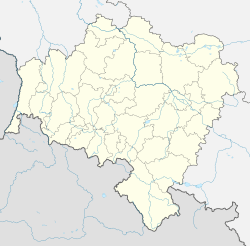Polkowice
Polkowice [pɔlkɔˈvʲit͡sɛ] (![]()
Polkowice | |
|---|---|
3.jpg) Market Square with the town hall and St. Barbara Church | |
 Flag  Coat of arms | |
 Polkowice  Polkowice | |
| Coordinates: 51°30′N 16°04′E | |
| Country | |
| Voivodeship | |
| County | Polkowice |
| Gmina | Polkowice |
| Government | |
| • Mayor | Łukasz Puźniecki |
| Area | |
| • Total | 23.75 km2 (9.17 sq mi) |
| Population (2019-06-30[1]) | |
| • Total | 22,480 |
| • Density | 950/km2 (2,500/sq mi) |
| Time zone | UTC+1 (CET) |
| • Summer (DST) | UTC+2 (CEST) |
| Postal code | 59-100, 59-101 |
| Area code(s) | +48 76 |
| Car plates | DPL |
| Climate | Dfb |
| Website | http://www.polkowice.pl |
Geography
Polkowice is located in historic Lower Silesia, about 15 km (9 mi) northwest of Lubin on National road 3. The nearest airport is Wrocław–Copernicus Airport, located 72 km (45 mi) from Polkowice.
Situated in a traditional mining region, the town is part of the largest industrial copper-extraction area in Poland, with a copper-processing plant operating nearby. Nearby Polkowice Dolne is the site of a former State Agricultural Farm (PGR) and, since 1998, of a Volkswagen diesel engine plant, another major employer in the region.
Designated as an urban-type settlement from 1945, Polkowice regained town status in 1967. In 1975–1998 it was in the former Legnica Voivodeship.
History
.jpg)
The name of the town is probably derived from Slavic (Old Polish) Boleslaw, meaning "great glory", a favoured dynastic name in the Polish royal House of Piast. According to legend, The Silesian duke Bolesław I the Tall (1127–1201) had a hunting lodge erected near the later town, later called Bolkewice or, adjusted to the German pronunciation, Polkovicz (1333). In the Statuta synodalia episcoporum Wratislaviensium from 1475 the town is named Polkewicze and Polkowice. As a result of the fragmentation of Poland into smaller duchies, it became part of the Duchy of Silesia, and later on the Duchy of Głogów. Polkowice was mentioned as a town (civitas) in a 1276 deed. It remained part of the Duchy of Głogów, ruled by the Polish houses of Piast and Jagiellon, including future Polish kings John I Albert and Sigismund I the Old, until the duchy's dissolution in 1506, when it was incorporated into the Bohemian (Czech) Kingdom.
Parts of the medieval town were destroyed by a blaze in 1457, it suffered further damages during the Thirty Years' War and by a plague epidemic in 1680. After the First Silesian War in 1742, the town was annexed by Prussia as Polkwitz and later incorporated into the Province of Silesia. Between 1871 and 1945 the town was part of Germany and was renamed Heerwegen in 1937 by German Nazi authorities during a campaign of erasing placenames of Polish origin. After Germany's defeat in World War II, the town became part of Poland. Its German-speaking population was expelled in totality.
In 2005 the neighbouring village of Polkowice Dolne was included within the town limits.
Education
- Lower Silesian College of Enterprise and Technology (Dolnośląska Wyższa Szkoła Przedsiębiorczości i Techniki)
Sport
- Górnik Polkowice – football team, playing in the Polish third division. The team played in the country's top flight in season 2003-2004
- MKS Polkowice – women's basketball team, 3rd place in Sharp Torell Basket Liga in 2004/2005 season
- CCC Polsat Polkowice – Road Cycling Team UCI Professional Continental team
Twin towns – sister cities
Gallery
 Saint Barbara church at night
Saint Barbara church at night- ZGZM (Copper Basin Gminas Association) Office
.jpg) Gdańska street
Gdańska street5.jpg) Town center
Town center Memorial stone dedicated to Polish copper miners
Memorial stone dedicated to Polish copper miners
References
- "Population. Size and structure and vital statistics in Poland by territorial divison in 2019. As of 30th June". stat.gov.pl. Statistics Poland. 2019-10-15. Retrieved 2020-02-14.
| Wikimedia Commons has media related to Polkowice. |
